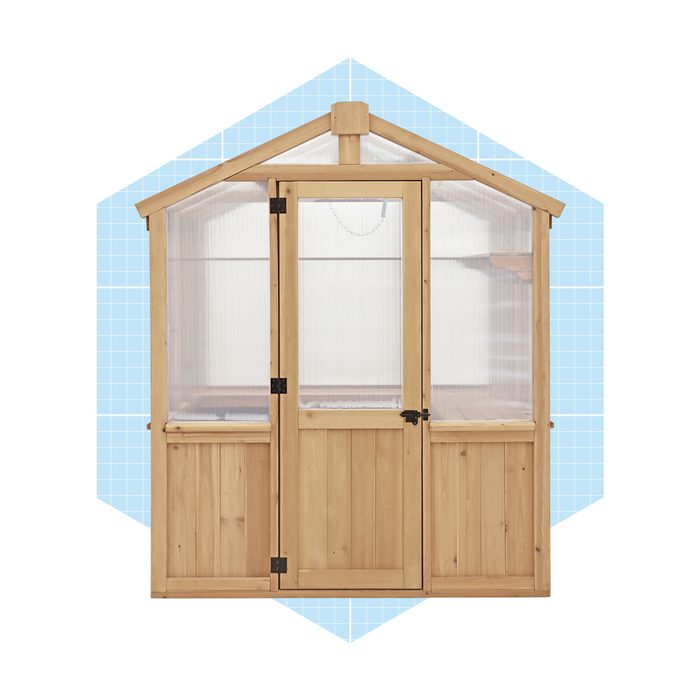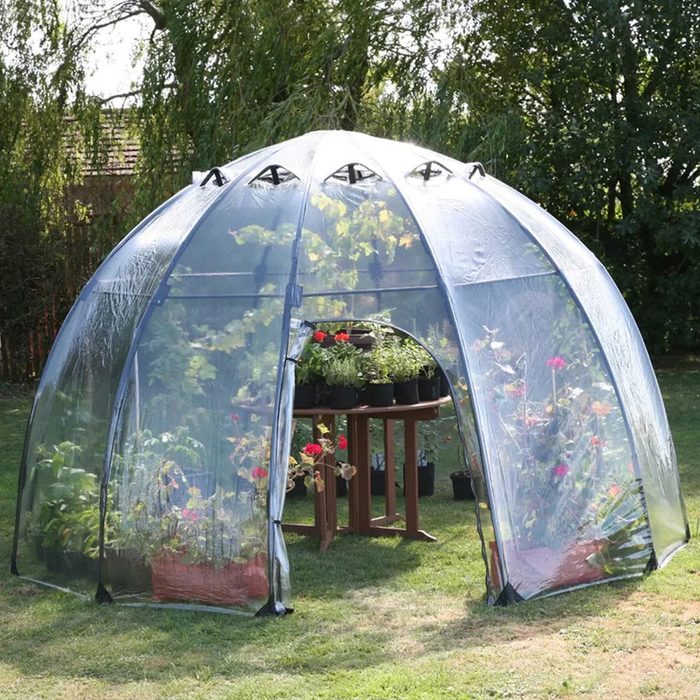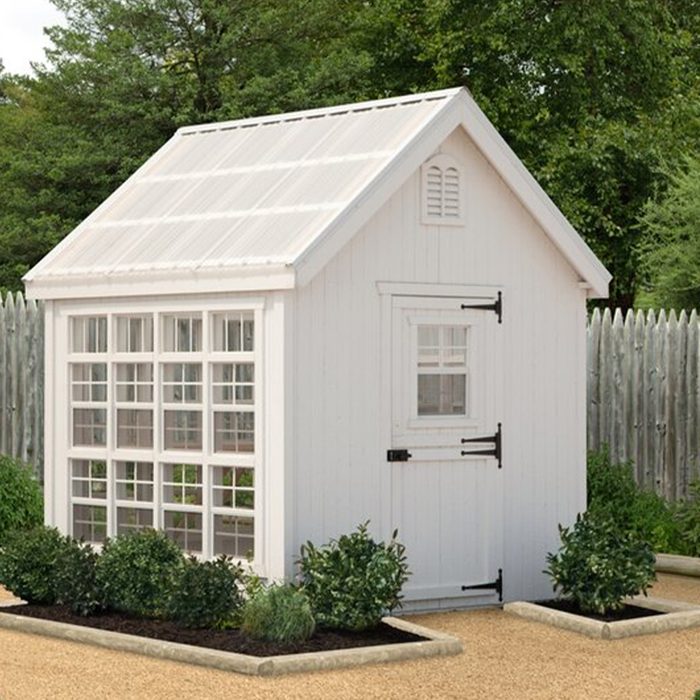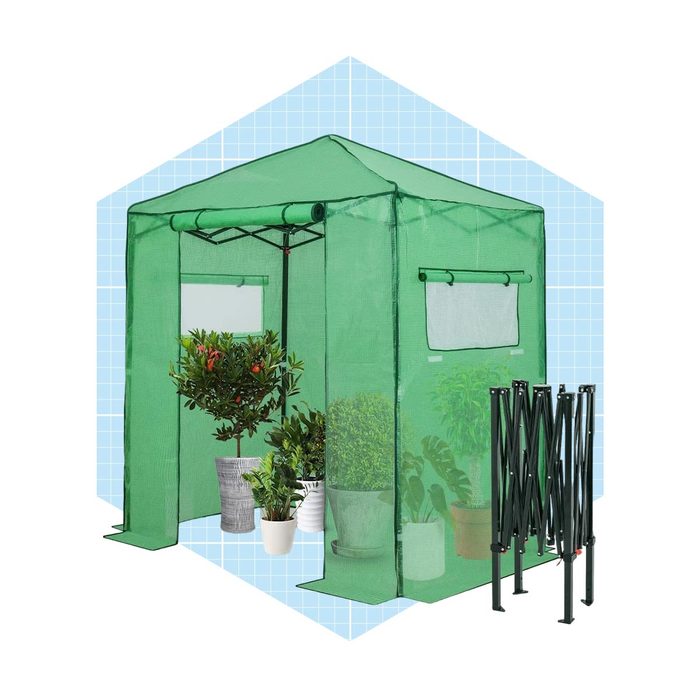via merchant
VIA MERCHANT
Pros:
-
Easily folds up for storage
-
23.4-pound weight capacity per tier
-
Tie-up door with zippers
-
Takes only 10 minutes to assemble
Cons:
-
Requires a drip catch tray when indoors
The Worth Garden Four-Tier Mini Greenhouse only has a 27-inch-by-19-inch footprint, so it’s easy to tuck away in the corner of the kitchen or on a balcony garden. And at 63 inches, it’s tall enough to accommodate up to four shelves for plants, flowers and gardening supplies.
The easy-to-assemble frame is steel, and the cover is clear PVC. The front cover can be rolled down to create a temperature-controlled environment for all-season growing, and the unit is sturdy enough to withstand winter’s ravages.
Dimensions: 27 x 19 x 63 in. | Frame Material: Steel | Cover Material: Clear polyethylene | Warranty: 12 years
East Road/Getty Images
What to Consider Before Purchasing a Greenhouse Kit
“While there is no doubt the vast majority of people consider purchasing a greenhouse for the main purpose of providing a little bit of extra warmth and protection for their crops, if you take a little time to select the right one for you, it can offer so much more,” says Joe.
A rudimentary greenhouse isn’t that difficult to build from scratch. I built mine from pressure-treated wood and recycled sliding glass door panels. But there are definite advantages to purchasing a ready-made kit:
- Choose the size and style that best suits your available land and growing needs
- Everything is included; simply assemble
- Depending on its size, your greenhouse may be portable
Here are some more things to consider as you shop for the best greenhouse kits:
Square Footage
Sizes range from cold frames, simple boxes you can move around the garden to 16-foot-by 20-foot walk-in greenhouses suitable for commercial production. It’s wise to buy the largest greenhouse your budget and space allow because once you start growing, there’s a good chance you’ll want more space.
“Greenhouses really do come in all shapes and sizes. I believe it is important to get the largest one possible for your available space and budget,” notes Joe. “It is surprising how fast you can fill up that valuable real estate inside your greenhouse, especially if you wish to add in furnishings such as shelves, potting benches and the like. Remember, it is far cheaper to purchase one 100-square-foot greenhouse than to buy two 50-square-foot greenhouses.”
Height
“When thinking about the size of your greenhouse, there is one dimension that is the most crucial, and that is the height,” notes Joe. “From experience, there is nothing more uncomfortable than not being able to fully stand up inside your greenhouse. A lot of the smaller greenhouses often have roof heights under six feet, which for someone who is on the taller side can make prolonged periods inside very uncomfortable. There are also a few obvious safety concerns with bumping your head against glass panels.”
“Having said that, you do not want your greenhouse to be too tall. Not only does this subject it to a higher chance of wind damage, but it may also mean you need planning permission to erect it (depending on local laws). The perfect height in my experience is between six and eight feet,” he says.
Frame Material
According to Joe, there is no right or wrong choice when it comes to the frame.
“I have four aluminum frame greenhouses, one steel and one wooden and they are all fantastic,” he says. “In theory, aluminum is more at risk when it comes to storm damage, but two of mine are over thirty years old and still standing. Wooden frames are slightly more maintenance, but I believe they look the best, and steel frames are very strong but do tend to get quite hot in the summer sun.”
Panel Material
There are a few materials to consider when looking at greenhouse panels. For the most part, folks choose between either glass, fiberglass or polycarbonate, which each have their own benefits and disadvantages. While glass is more likely to break, plastic and polycarbonate panels often run the risk of sun damage, which means they’re also not immune from replacements.
“When it comes to glass versus plastic, I would recommend glass virtually every time,” says Joe.”Over the years, I’ve replaced the odd broken panel, but the vast majority are still the originals. My experience with plastic has not been great. After a few years of being exposed to the elements, mainly the sun, it often starts to discolor, which blocks out that all-important sunlight, as well as becoming quite brittle.”
Light Diffusion
Transparent material is best for starting seeds. But if you’re growing plants to maturity, diffuse or semi-diffuse is better. It distributes light more evenly and prevents plants from getting “leggy” as they reach upwards toward a more focused light source.
Durability
You need a rigid, well-insulating material like glass or multiple-walled polycarbonate sheets if you have cold winters with a lot of snow. You also need a rigid material if you experience frequent high winds. Metal and wood framing work better than plastic in these conditions.
Style
A greenhouse impacts the appearance of your property and the neighborhood. The right design can add appeal and utility, whether a lean-to extending from the back of a brick house or a Gothic arch in the back of the yard. On the other hand, aesthetics may not be an issue if your greenhouse is small and portable or if you’re adding a large greenhouse to a space already devoted to growing.
Manufacturer
It makes a difference who manufactures the greenhouse. Is the manufacturer local or based in another country? How easily can you get technical support? What kind of warranty comes with the kit?
Cost
In general, it’s cheaper to build a greenhouse (like I did, using recycled materials) than to buy a kit. However, considering greenhouse kits range from $100 to $10,000, the cost differential may not be significant depending on size and style.
Permits
Check your local zoning regulations before you purchase a greenhouse, especially a big one. Some communities regulate them. A lean-to or abutting greenhouse is considered part of the structure of a house, so you may need a building permit.
Garden Aesthetic
“It is very important to think about the look and design of your garden. These days greenhouses come in a variety of colours and designs to match any sort of garden look,” says Joe. “If you have a grand house and traditional country garden it might be worth looking at the Victorian style of greenhouses with their embellished roofs. Alternatively, if you have more of a cottage-style garden, then I like natural wood greenhouses.”
What You Want to Grow
“Without a doubt, one of the most important factors to consider when deciding what greenhouse might be for you is to think about what purpose you need it for,” notes Joe. “If you want a space to grow larger crops such as tomatoes with the added protection from the weather, then you will need a different type of greenhouse to someone who maybe just wants a warm place to start seeds, and keep potted plants.”
“This matters quite a lot because you need to decide what base you want, and while a concrete base is ideal for some, if you plan to grow directly into your greenhouse then you will need one without a base, and most likely without shelves and benches.”
Why You Should Trust Us
I have been active in the building trades for more than 30 years. I helped build a small city in the Oregon desert from the ground up and helped establish two landscaping companies. I’ve also worked as a carpenter, plumber and furniture refinisher. My work also includes employment as an online consultant, most recently with Home Depot’s Pro Referral service.
Emily Way is an Associate Shopping Editor for Family Handyman with experience researching products and recommending the best designs to consumers. She researched and updated this piece.
Way consulted Instagram and TikTok gardening influencer Joe of @joesgarden for information and tips on maintaining and buying greenhouses.
How We Found the Best Greenhouse Kits
We found each of the best greenhouse kits on this list by combing through user reviews, specifications and product descriptions to ensure that each pick is truly the best. When looking for the best greenhouse kits, we kept the following criteria in mind:
- Durability: Greenhouses, for the most part, sit outside year-round. This means that each pick should be constructed from durable materials that resist rain, wind, snow and freezing temperatures. For some picks that don’t offer such durability, like the budget pick, we ensured that it’s easy to pack up and put away when the weather turns.
- Ventilation: All greenhouses require some sort of ventilation to avoid cooking plants. Whether it’s a flap, roof vent, windows or fans, each choice on this list includes at least one method of ventilation.
- Size: We included a variety of sizes to choose from. These range from modest pop-up portable greenhouses to large, 10-foot models that stay out all year round.
- Price: Typically, the larger and sturdier the greenhouse, the pricier it gets. While we did include a few pricey options for those looking to splurge, a few picks (like our overall best pick) come at a lower price point. These models typically require a little more DIY ingenuity to ensure stability, but we find that the lower price makes it well worth the extra work.
FAQ
Is it cheaper to build or buy a greenhouse?
“A question that I hear a lot is whether it is cheaper to buy or build your greenhouse,” says Joe. “If I am honest, you can save a little bit of money building your own greenhouse, but with the rising cost of timber, this is getting less and less every year. I would always recommend leaving any larger builds to the experts and spending the money to get a properly built greenhouse.”
“Any savings you might make are soon offset once you factor in your time, the overall quality and the lack of any form of warranty. If you are only wanting a very small, cold frame-style greenhouse, then yes, it may be worth building it yourself, but for anything slightly larger, I would leave it to the professionals, unless you are lucky enough to be highly skilled at DIY.”
What type of greenhouse is best for winter?
According to Joe, any modifications you make are much more of a difference than the type of greenhouse you choose. He notes that in mid-winter, you will need a greenhouse with a proper closing door on hinges rather than one on rollers as that will always leave gaps. The same applies to windows and vents. Finally, even the most well-insulated greenhouse needs some form of greenhouse heater.
Even more important than heat is light, though. “Without enough light, you will have very little success. Regularly clean your glass to ensure as much valuable winter sunlight as possible can get in,” says Joe.
How are greenhouse kits delivered?
It differs depending on the company and size of the greenhouse, but typically, greenhouse kits are delivered to your curbside unless you choose to spring for professional installation. Some companies may call to schedule the delivery ahead of time.
































